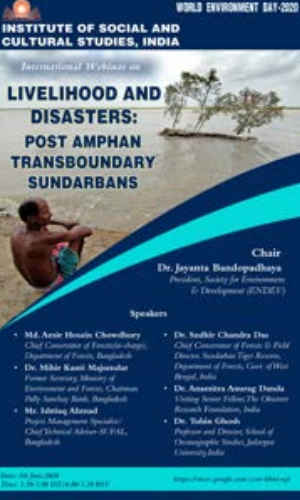Report of the1st International Webinar on -“Livelihood and Disasters: Post Amphan Transboundary Sundarbans”
- 5th June 2020
The Institute of Social and Cultural Studies organized Webinar on -“Livelihood and Disasters: Post Amphan Transboundary Sundarbans” held on – 5th June 2020 started with a welcome address by Sri. HeerakNandy, Senior Associate,ISCS who introduced all the speakers and the Chair to the participants of the Webinar.
The Chair Dr..Jayanta Bandyopadhyay, President – Society for Environment and Development divulged the relationship between livelihoods and natural disasters in an area Sundarban which neededto be assessed through a multi-level analysis. Especially In the case of the residents in the Sundarbans and adjoining areas, as the forests were first felled by the East India Company during the 1780s to bring out land for revenue villages.. That started the process of occupation of the land and search for livelihoods.
Availability of good soil and water facilitated the growth of population. The recent cyclone Amphan and the global forecast of more intense cyclonic events had posed a serious question on the sustainability of the routine ways of seeking livelihoods in a settled farming scenario. This was equally applicable to the Sundarbans both in Bangladesh and India.
Dr.Farid Uddin Ahmed, Executive Director Arannayk Foundation counted the threats that these cyclones added to the adjoining India –Bangladesh risking the livelihood practices of the residents who were dependent largely on agriculture. He rested on synthesizing pragmatics and efficient management skills to resist the effect of these cyclones on the people of the region. Most importantly his deliberation noted the fact that how these climatic calamities reflected the unity among the neighbouring’s who in the time of crisis desperately extended out support for each other.
Dr.SudhirChnadra Das ,Chief Conservator of Forests and field Director, Sundarbans Tiger Reserve, Department of Forests, Government of West Bengal India and an area expert of Sundarbans identified that climatic disasters, cyclonic storms as some of the common phenomena of the region, but Amphan he said had laid a miserable impact on certain part of Sundarban reserve forests and to 4000 people of that particular region who were solely dependent on honey collection and various aspects related to agriculture.
As the tides of winds had lashed infrastructure, roofs of the houses of the residents and agricultural infrastructure to a large extent he meted his concern about the fact that as at this point of time when people were bearing the distressful impact of COVID a parallel natural disasters like Amphan had thrown a bigger challenge of the ecology and sustainability.
Dr.MihirKanti Majumdar, Former Secretary, Ministry of Environment and Forests, Chairman Pally Sanchay Bank , Bangladesh on a similar note described about the economic losses that Bangladesh had to bear post Amphan as it had wiped out the crops hence according to him the existing situation would have a gruelling impact on the nation’s economy in coming times. He added that administration had
to take a proactive step to ensure the ransacked region, economy and sustainability of people were back on track at the earliest.
Dr.Tuhin Ghosh, Professor and Director, School of Oceanographic Studies, Jadavpur University over his statistical analysis and figures tried to skim the economic gridlocks that India and especially the State had to confront post Amphan disaster. Mr.IshtiaqAhmad, Project Management Specialist/ Chief Technical Adviser-SUFAL, Bangladesh who had been a project Management specialists enlisted numerous
proactive steps and measures that the government would undertake to stall the hazardous impact of these storms in the region of Sundarbans and its adjoining , he emphasised on imparting various training programs among the localities of the region to prevent them and their agricultural land beforehand. He highlighted that the authorities who were vested with power would address that the lacuna was
meted between the policies and practicing mechanisms.
Dr.Anamitra Anurag Danda, Visiting Senior Fellow, The Observer Research Foundation who narrated the historic perspectives of land Sundarbans further describing threats and need of initiating prudent management steps likewise other speakers and added that it was ironic that one of the most bio-Diverse zone of the state was the most vulnerable to climate disaster.
The recent devastation and the evident impact of climate change meant the people, flora and fauna of the Sundarbans needed to be cared and protected like never before. While summarizing the session the Chair of the Webinar stressed upon the fact that ,since there was
no hope of situation to arrest of global warming, and environmental hazards the cyclones were expected to become more intense. This also opened the option of informed and voluntary relocation of people in the very vulnerable areas, needed for sensitization among people regarding climate change and an alarming global warming. This also was opening up of opportunity for proactively activating the MoA of
2011, for sustainable collaboration between India –Bangladesh on Sundarbans to battle against the onslaughts of climatic change and fostering the ecology and habitability of the mangrove. The enriching hosted Webinar concluded with a vote of thanks bySri KrishnenduBaksi, (Program Coordinator , ISCS) .





